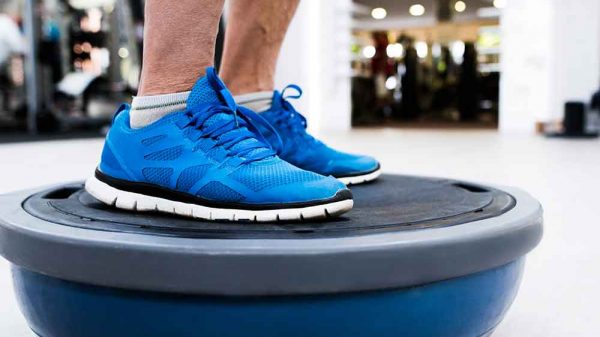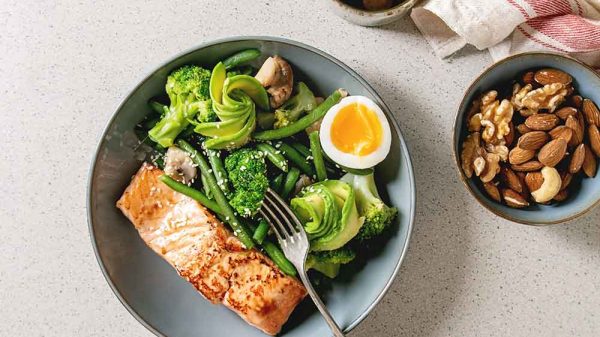“Strong is the new skinny.” We are hearing this catchphrase all over the internet and social media these days. Being strong is not only a plus for aesthetic purposes but also for your health. But how do you effectively put on lean muscle tissue and support lean body mass? What should you eat to gain muscle, and how many calories should I eat to gain muscle?
In this article, we tell you what you need to know about increasing your muscle mass. Read on to find out more!
Why Is Muscle Healthy?
Having a healthy body composition supports your overall health and wellness. Here are a few reasons why having lean muscle tissue improves your health.
Increased Strength
If you have a higher muscle mass percentage and lower body fat percentage, you will be stronger and more energized. You will be able to exert more energy daily, and as a result, your quality of life will increase. Having a higher muscle mass percentage is especially crucial for older individuals who are more prone to fatigue and weakness that accompanies age-related muscle wasting.
Lower Risk of Injury
Muscles play a key role in protecting the body against injury. The body’s structural elements like bones, joints, tendons, and ligaments can experience injury through intense physical exertion or prolonged wear-and-tear through the aging process. However, the body is much less prone to injury when you have a higher percentage of lean muscle tissue. Muscle tissue surrounds bones, joints, and connective tissue and supports the body at all junctures, absorbing stress and pressure.
Faster Healing
Research reveals the critical link between muscle mass and immune system function. The essential amino acids present in muscle tissue are critical components in the immune system’s response to injury. Research also suggests that having low muscle mass is connected to a worse stress response. (1)
Faster Metabolism
In comparison to fat tissue, muscle tissue requires much more energy to maintain. Even at rest, muscle cells require much more energy to keep up with demands. As a result, having a higher percentage of muscle mass increases your resting metabolic rate. Having a higher metabolic rate can help you maintain a healthy weight and burn fat more efficiently.
How to Build Lean Muscle
There are three primary components to gaining muscle mass: eating the right amount, eating the right foods, and exercising. It’s important to be consistent with your diet and exercise regimen in order to encourage muscle growth.
How Much You Should Eat
One of the frequently asked questions when it comes to supporting muscle synthesis is “how many calories should I eat to gain muscle?”
The answer is not so simple. Unfortunately, there is not a magic number of calories that will guarantee muscle growth. Instead, the number of calories you should eat depends mainly on your specific metabolism, your age, your starting weight, and your activity level. You will need to eat more calories if you are striving for bodybuilding and bulking, while you will need to eat fewer calories if you’re also striving for fat loss or weight loss.
Younger or very active individuals will need to eat more calories to gain muscle mass than individuals who are older or less active. If you are overweight and striving to lose weight, you will need to create a calorie deficit to ensure that you are burning more energy than you’re consuming. Most individuals will need to eat at least 2000 calories in order to gain muscle. If you want to maintain your current weight, calories in and calories out should be approximately equal.
A registered dietitian or personal trainer can help you find the appropriate caloric intake or the number of calories that fit your needs while helping you build muscle. You can also use a calorie calculator to find the approximate calorie intake that works for you and your calorie needs.
How many calories per meal should you aim for? It’s best to spread your total calories out throughout the day, to avoid overeating or undereating, and to keep your blood sugar stable. For example, if you are aiming for 2000 calories per day, aim to consume four meals per day, each providing approximately 500 calories.
What You Should Eat
In addition to your calorie intake, it’s critical to eat the right foods when striving to gain muscle mass. Here are some of the critical guidelines to follow on a muscle-building diet.
Eating a Balance of Macronutrients
Macronutrients are the elements in food that provide calories. These elements include fat, protein, and carbohydrates. Balancing these nutrients is key to ensuring that your body is properly energized to burn fat and build muscle.
Carbs
Carbohydrates are large compounds that are broken down into glucose molecules for energy. Eating a sufficient number of grams of carbs is critical for fueling tough workouts and for replenishing glycogen stores.
When fueling up with carbohydrates, choose complex carbohydrates that are digested slowly and packed with fiber. Complex carbs include foods like fruit and whole grains.
Simple carbs, on the other hand, are quickly broken down into glucose that enters the bloodstream and causes blood sugar levels to skyrocket. High blood sugar levels can cause systemic inflammation that impedes muscle-building processes. Moreover, chronically high blood sugar levels contribute to the development of metabolic conditions like insulin resistance, type 2 diabetes, and fatty liver disease.
Fat
Fat is a crucial food component that the body uses to fortify membranous structures and to reduce inflammation. Plus, fat is the most calorie-dense macronutrient that supplies lots of energy. However, it’s important to choose the right fats to support muscle development. Monounsaturated fats and polyunsaturated fats are the best fats to eat. You can find these healthy fats in foods like avocados, olive oil, pumpkin seeds, walnuts, almonds, pecans, chia seeds, flaxseeds, and fatty fish like salmon, mackerel, and sardines.
On a muscle-building diet, it’s also important to avoid saturated fats and trans fats. These fats are inflammatory agents for the body and can slow down muscle-building processes. To avoid these fats, stay away from fatty meat and dairy products like fatty cuts of steak, deli meats, bacon, whole milk, butter, and full-fat cheese. It’s also important to avoid fast foods, restaurant foods, and frozen prepared meals.
Protein
When it comes to building muscle, protein is the most important macronutrient because it directly provides the building blocks for the synthesis of muscle tissue. When we eat dietary protein, we are consuming configurations of amino acids. These whole proteins are broken down into individual amino acids in the digestive system before being sent throughout the body to be used for a variety of cellular processes, including muscle production. The body organizes amino acids in specific arrangements to create muscle fibers.
Eating enough grams of protein is important for supporting muscle growth. However, the composition of your protein intake is also critical.
The body uses essential amino acids and nonessential amino acids in different cellular mechanisms. Essential amino acids are the most important when it comes to producing muscle growth. The body requires optimal ratios of essential amino acids on a daily basis to efficiently produce muscle tissue. If the body is missing any one essential amino acid, muscle-building processes slow down.
To ensure that you’re getting the essential amino acids you need, it’s important to eat high-quality protein each day. Animal products like cheese, milk, and yogurt offer balanced ratios of essential amino acids. Vegetable proteins, on the other hand, do not contain optimal ratios of essential amino acids. To obtain ideal ratios of essential amino acids from veggie-based proteins, eat a variety of plant proteins on a daily basis.
Supplementation with protein powders like whey protein or casein may also help you reach your essential amino acid needs. However, supplementation with optimal ratios of pure essential amino acids is also a good idea, to fill in any gaps in your diet or to fortify your diet and further stimulate muscle growth. The body is able to more efficiently digest and utilize individual amino acids than amino acids in protein particles like whey.
The Importance of Strength Training
Your diet is one piece of the puzzle when it comes to building muscle; strength training is the other. Without regular exercise, the body won’t spontaneously build muscle. Instead, it’s crucial to incorporate several strength training or resistance training sessions into your weekly routine.
Of course, you don’t need to engage in bodybuilding exercises. Bodyweight exercises and other strength training exercises are sufficient to kickstart the muscle-building process. As you gain strength, you can engage in increasingly difficult exercises.
Why is strength training so vital to your muscle-gaining goals? Strength training challenges your muscles, causing you to exert a significant amount of energy. As you lift something heavy, muscle fibers will tear. Throughout the recovery period, your body works hard to repair muscle fibers, making them stronger in the process.
Examples of Strength Training Exercises
Here are a few examples of strength training exercises that you can incorporate into your regimen.
1. Shoulder Presses
To perform shoulder presses, hold a dumbbell in each arm while standing or sitting with a straight back. Lift the dumbbells above your head and back to shoulder level. If you don’t have dumbbells, use other weighted objects such as cans or large water bottles.
2. Push-Ups and Pull-Ups
Push-ups and pull-ups are bodyweight exercises that challenge your upper body strength, especially in the arms, shoulders, and upper back. Incorporating these exercises into exercise daily routine is an excellent strategy for improving muscle strength.
3. Weighted Squats
Weight squats help strengthen muscles in the legs and glutes. To perform a weighted squat, hold a dumbbell in each hand, and hold them up close to your shoulders. Stand with your feet shoulder-width apart, squat like you are going to sit down, maintaining a straight back. Return to a standing position and repeat 10-15 times.
More Tips for Building and Maintaining Muscle
Beyond having an ideal daily calorie intake, balancing your nutrition, and engaging in strength training, there are a few key tips to supporting your muscle-building goals.
1. Proper Recovery After Workouts
In order to maximize the effectiveness of weight training workouts, it’s important to give your muscles a break to repair and revitalize. Resting your muscles means not training them for about 24 hours. Resting after workouts allows your body to channel energy and resources towards rebuilding and strengthening muscle fibers. For this reason, many athletes alternate the days they work out muscle groups. For example, if you train the shoulder and arms on one day, you should focus on the glutes and leg muscles the next day, to give the upper body a break to heal.
Recovery also involves getting proper nutrition while recovering. Making shakes packed with protein and balanced ratios of essential amino acids is a great strategy for refueling and providing your body with the resources necessary to build muscle.
A high-protein shake provides your body with the raw materials it needs to build muscle after a workout. These raw materials are amino acids, which are incorporated into numerous cellular processes, including muscle synthesis.
2. Making a Meal Plan
Planning your meals is crucial to prevent you from falling off track. Planning your meals and even preparing some meals ahead of time helps save time and energy. Try setting aside a little time each weekend to go through your pantry, write a grocery list, prep meals, and plan food for the upcoming week. When you have a food plan, you are less likely to be tempted by treats, snacks, and take-out. Meal planning can be helpful for managing the amount of calories you consume and keep you on track with your muscle-building goals.
3. Think Less About the Scale
If you are overweight and striving to lose fat while gaining muscle, it may be helpful to look at the scale. However, in general, it’s a good idea to weigh yourself very infrequently. If you are at a healthy weight and striving to increase your lean muscle mass, you will likely gain weight as your muscle mass increases. Muscle tissue is significantly more dense than fat tissue. So, even if you’re fitting into your clothes better, the scale may show that you’re putting on a few pounds.
Instead of relying on the scale, focus on how you feel in terms of daily energy and strength, as well as how your clothes fit. These are much better indicators of muscle growth than the number on the scale.
Things to Keep in Mind
If you have specific health conditions, it’s a good idea to talk to your doctor, who can provide medical advice about the best way to train. A physical therapist and certified personal trainer are also vital resources if you are striving to gain muscle while healing from an injury.
It’s also important to keep in mind that a large calorie surplus or intake of additional calories can lead to fat gain, especially without physical activity. At the same time, it’s important to avoid slashing your calorie intake too much, since inadequate food intake can lead to muscle wasting and nutrient deficiencies.
How much muscle can you gain in a year? Though rates of muscle growth vary depending on many factors, it is possible to gain about 2 pounds of muscle each month. That means that in a year, it’s possible to put on nearly 25 pounds of muscle when being consistent with diet and exercise regimens.
Conclusion: How Many Calories Should I Eat to Gain Muscle?
Having a balanced calorie intake that matches your age, metabolic rate, and activity level is crucial to supporting muscle synthesis. At the end of the day, muscle growth relies on many other factors in addition to calorie consumption. Eating healthy foods, getting optimal ratios of essential amino acids, and engaging in consistent strength training is crucial to supporting muscle synthesis.
References:























